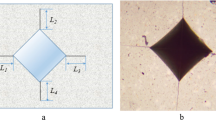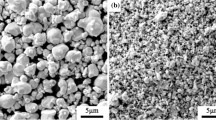Abstract
HIP treatment after sintering increases the strength of the investigated cemented carbide alloy by a factor of two whereas hardness, fracture toughness, and work of fracture remain unchanged. HIP does not affect the microstructural parameters of the carbide skeleton and the binder phase, but the residual pores are eliminated entirely. Failure of both the as-sintered and post-densified material occurs by a pure Griffith mechanism. The strength-flaw size relationship is established experimentally and is shown to obey exactly Griffith's basic strength equation. The strength is controlled by the largest microstructural defects, i.e. pores in the as-sintered material, and coarse WC grains and inclusions in the HIP-treated specimens.
Similar content being viewed by others
Abbreviations
- a :
-
size of the fracture initiating flaw
- a th :
-
theoretical flaw size
- b :
-
sample thickness
- c :
-
length of the pre-crack
- C :
-
contiguity of the carbide phase
- D WC :
-
mean carbide grain size
- E :
-
Young's modulus
- F :
-
fracture surface
- G IC :
-
critical energy release rate
- h :
-
sample height
- H V :
-
Vicker's hardness
- K IC :
-
critical stress intensity factor
- l :
-
span length
- l Co :
-
mean Co layer thickness
- m :
-
Weibull parameter
- P :
-
load
- r p1 :
-
radius of the plastic zone
- R :
-
crack resistance
- S :
-
probability of failure
- U :
-
fracture energy
- X :
-
relative crack length
- Y :
-
K-calibration
- γ F :
-
specific work of fracture
- γ I :
-
specific energy for fracture initiation
- ε :
-
spread of grain size distribution
- λ :
-
compliance of the pre-cracked specimen
- λ 0 :
-
compliance of the uncracked specimen
- v :
-
Poisson's ratio
- σ :
-
fracture stress
- σ 0 :
-
maximum stress
- σ B :
-
bend strength
- σ Y :
-
Yield strength
- σ eff :
-
maximum local stress
References
P. B. Anderson,Planseeber. Pulvermet. 15 (1967) 180.
H. Suzuki andK. Hayashi,ibid 23 (1975) 24.
E. Lardner andD. J. Bettle,Metals Mater. 7 (1973) 540.
O. Rüdiger andH. E. Exner,Powder Met. Int. 8 (1976) 7.
R. W. Davidge andA. G. Evans,Mater. Sci. Eng. 6 (1970) 281.
P. Kenny,Powder Met. 14 (1971) 22.
N. Ingelström andH. Nordberg,Eng. Fracture Mech. 6 (1974) 597.
W. Dawihl, O. Jung, andE. Kohlhaas,Arch. Eisenhüttenwes. 45 (1974) 729.
J. L. Chermant andF. Osterstock,J. Mater. Sci. 11 (1976) 1939.
H. E. Exner, A. Walter, andR. Pabst,Mater. Sci. Eng. 16 (1974) 231.
H. Hübner,Z. Metallkde. 67 (1976) 507.
H. Hübner andU. Engel,Z. Werkstofftechnik 9 (1978) 128.
H. E. Exner,Prakt. Metallog. 3 (1966) 334.
Idem, Metall. 21 (1967) 431.
J. Nakayama,J. Amer. Ceram. Soc. 48 (1965) 583.
H. G. Tattersall andG. Tappin,J. Mater. Sci. 1 (1966) 296.
H. Hübner andW. Jillek,ibid. 12 (1977) 117.
E. Almond andR. Roebuck,Powder Met. 19 (1976) 109.
S. Bartolucci-Luyckx,Acta Met. 23 (1975) 109.
H. Suzuki, T. Tomae, andK. Hayashi,Planseeber. Pulvermet. 23 (1975) 121.
G. R. Irvin “Handbuch der Physik” Vol. VI (ed. S. Flügge) (Springer-Verlag, 1958).
J. Burbach,Techn. Mitt. Krupp, Forsch. Ber. 26 (1968) 1.
W. F. Brown andJ. E. Srawley, ASTM STP 410 (1966).
H. Hubner andW. Strobl,Ber. DKG 54 (1977) 401.
F. W. Kleinlein andH. Hübner, Proc. ICF4, Waterloo 1977, Vol. 3, p. 883.
Author information
Authors and Affiliations
Rights and permissions
About this article
Cite this article
Engel, U., Hübner, H. Strength improvement of cemented carbides by hot isostatic pressing (HIP). J Mater Sci 13, 2003–2012 (1978). https://doi.org/10.1007/BF00552908
Received:
Accepted:
Issue Date:
DOI: https://doi.org/10.1007/BF00552908




